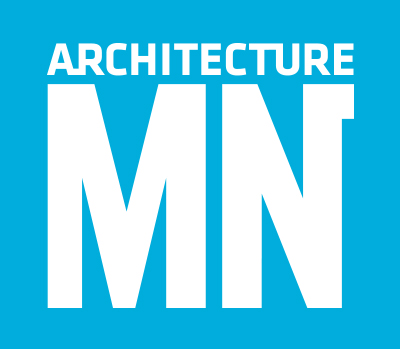A credit-union-turned-library designed by modernist architect Ralph Rapson becomes a full-fledged, 21st-century library with help from MacDonald & Mack Architects
By Joel Hoekstra
Are brutalist buildings worth saving? It’s a debated question in many communities. Four years ago, Hennepin County officials answered “yes” when they voted to renovate rather than replace the 1964 Ralph Rapson–designed, brick-and-concrete structure that had housed, for a half-century, Hennepin County Library’s Southeast Library in Minneapolis. The remodeled facility, freshened up on the exterior and retooled on the inside to meet the needs of today’s patrons, opened this past winter. The library was also renamed, after women’s rights advocate Arvonne Fraser.
Originally designed to house a credit union, the one-story Dinkytown building sits up on a quarry-tile-topped plinth above the street and is best known for its imposing waffle-slab roof—so named because of the gridded pattern of the concrete ribs on the underside of the roof. The humongous lid is supported by 16 cross-shaped pillars, which allowed the architect to top the exterior walls with continuous clerestory windows.
From the start, the interior was mostly open and illuminated by two dozen skylights of varying sizes that pierced the waffle ceiling in a random pattern. The ceiling of the boardroom in the lower level featured several stalactite-like forms that Rapson dubbed “light scoops.” In 1967, Rapson’s firm was hired to convert the building to a library—a renovation that essentially just removed teller stations and added bookshelves. The bank vault remained intact. Lending changed—from bills to books.
A Playful Plan
The most recent renovation was overseen by MacDonald & Mack Architects, a Minneapolis firm that specializes in historic preservation, in partnership with Washington, D.C.–based Quinn Evans Architects and Minneapolis landscape architecture firm Damon Farber. MacDonald & Mack partner Todd Grover, AIA, says initial discussions with library staff highlighted the need for more flexible spaces, mechanical upgrades, and fresh finishes. Water damage had rendered the basement almost unusable. “The staff had completely abandoned it by the time we arrived,” says the architect.
But overall there was an appreciation for Rapson’s design. “There’s a playfulness to the building,” says Grover. “You can see where he was pushing and pulling the walls to create interior spaces. Sometimes he would connect walls to the clerestory windows, but not always.”
Nobody wanted to meddle much with Rapson’s creation, but Grover and his team soon realized that the only way to gain more square footage was to access the basement—a move that would double the building’s usable space. To make that dark, windowless space inviting would require a significant change: A section of concrete floor was cut out to create a 14-by-23-foot opening into the lower level. Daylight from the largest skylights now floods a new lower-level reading area, enticing patrons to head downstairs.
The main level features a computer room, study rooms, and staff offices. An elevator was integrated into the floor plan, and the old boardroom (with its playful “scoops”) was converted into a kids’ play area. Maple bookshelves were added, but their height was capped to allow better visual connections with the waffle-slab ceiling and to allow light to flow more evenly through the space. Contemporary furniture, including a few pieces modeled on Rapson designs, makes lounging, reading, and gathering more comfortable.
Reading, Recycling, and Renewables
During the renovation, the architects and contractors sought to recycle waste materials whenever possible. All exterior windows were kept and brick from modified walls was cleaned and reused. Original doors were repaired and rehung. Demolition materials were recycled, even if it meant taking extra steps to sort the waste. “We were able to salvage a significant amount of material,” says Grover.
Sustainability and energy efficiency were also project priorities. A new energy-efficient HVAC system and new LED lighting with daylighting controls were installed. Furniture, finishes, and carpeting were chosen with a preference for products made sustainably and from recycled or renewable materials. Plumbing fixtures with automatic sensors and metering controls reduce overall water use.
But it’s the newly created volume of light and the bright furnishings throughout that have enhanced the appeal of this brutalist landmark for new generations of users.
Hennepin County Property Services’ Valerie Carr says the updated design is better able to meet the needs of the Dinkytown community. Unlike library facilities at the nearby University of Minnesota, the Arvonne Fraser Library caters to families with young kids and college students looking for an off-campus hangout. “This design is more welcoming to them,” says Carr. “It feels more welcoming for everyone.”
ARVONNE FRASER LIBRARY
Location: Minneapolis, Minnesota
Client: Hennepin County Library
Architects: MacDonald & Mack Architects (firm of record) with Quinn Evans Architects (collaborating firm)
Landscape architect: Damon Farber
General contractor: Shaw-Lundquist Associates
Size: 13,186 gross square feet
Cost: $12 million
Completion: February 2020
Photographer: Peter J. Sieger
“The American psychologist Abraham Maslow observed that ‘almost all creativity involves purposeful play,’ which helps explain the appeal of Ralph Rapson’s architecture. Rapson established simple forms and then purposefully played with them: placing brick pavilions under a hovering roof, carving an entry out of a white-walled block, or surprising us with daylight at the centers of his buildings. The playfulness of Rapson’s architecture stirs our own creativity, prompting us to love and care for his buildings.” —Thomas Fisher, Assoc. AIA, director of the Minnesota Design Center


